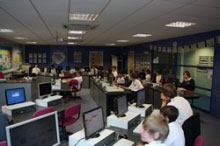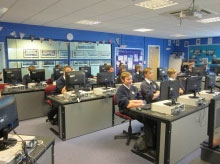Information & Communications Technology
Key Stage 3

At Christleton High School we aim to develop and stimulate students’ curiosity, interest and enjoyment in Computer Science and I.C.T. Students should gain skills to support lifelong study and prospective employment in a modern technological society.
The department has a suite of 4 dedicated computing rooms, with colour printing facilities, scanners, digital video and still photography. Students have the use of a large number of software applications and packages to support learning.
Topics covered during Key Stage 3 include an emphasis on the safe use of computer systems and online safety, we dedicate at least 1 lesson a half term to esafety. Our esafety topics are taken for new technological developments as well as suggestions from parents and students.
In Key Stage 3 all students attend discrete Computer Science lessons for two periods a fortnight. Students follow a tailored programme of study during Year 7, 8 and 9. This has been designed to incorporate skills in application packages which the students should find useful in other subject areas, together with an understanding of the principles of computer science. The Key Stage 3 roadmap incorporates elements which provide skills for both the computer science and Digital Information Technology (DIT) pathways at Key Stage 4. They include topics such as python programming, system security and data manipulation.
The department ensures they challenge the gender stereotypes that are often associated with the computer science sector, including running Yr 8 National computing challenge, displays on pioneering women in the computing industry and when possible inviting inspiring female speakers from the computing community.
ICT is used extensively throughout the school and students have access to ICT facilities in many departments including other ICT rooms and tablet devices.
Key Stage 4

Students can follow 2 potential pathways at Key Stage 4, these are GCSE computer science and Digital Information Technology (DIT). To use a car analogy to explain this, then DIT is like driving the car, it gives you the skills you will find useful for the rest of your life and will help you be more confident whenever you come to use a computer. In comparison Computer Science is like learning to be a mechanic. It gives you the ability to understand what is happening "under the bonnet" and be able to diagnose and fix many problems you might be having. Not everyone needs or wants to know how a car works in order to drive it - just like many students do not care how the computer works, but are more interested in what they can do with the computer instead. If this is the case then DIT is for you!
The Digital Information Technology course is made up of 3 key elements:
Slide right to see full calendar as required
| Unit | Assessment | Overview | % Of Final Grade |
| Unit 1 - Exploring User Interface Design Principles and Planning Techniques | Internal | This involves creating an user interface for a changing scenario, it allows users to build a product which meets the design specification. | 30% |
| Unit 2 - Collecting, Presenting and Interpreting Data | Internal | This involves creating a digital dashboard for a chosen data set, you will analyse the data to identify key trends/or findings which may interest the data users. | 30% |
| Unit 3 - Effective Digital Working Practices | External | This is an external exam which will be completed in the summer of Yr 11. | 40% |
The internal assessments follow a specified assessment window which falls either between Oct - Dec or from March - May, within this window pupils are given approx 6 hours to complete the assessment. Pupils are expected to complete the assessment in supervised conditions within lessons.
The theory content covers a range of topic areas including computer security to data flow within businesses. Pupils get an opportunity to learn a wide variety of skills in a practical manner and with regular feedback and deadlines.
To find out more information about the course please use the links below:
Downloads
| Title | |
| GCSE Bus Road Map | Download |
| ICT KS3 Year 7 Assessment Grid - Basic Binary | Download |
| ICT KS3 Year 7 Assessment Grid - Computer Legislation | Download |
| ICT KS3 Year 7 Assessment Grid - Data Flow Diagrams | Download |
| ICT KS3 Year 7 Assessment Grid - Input/Output/Storage Devices | Download |
| ICT KS3 Year 8 Assessment Grid - Advanced Binary | Download |
| ICT KS3 Year 8 Assessment Grid - Networks | Download |
| ICT KS3 Year 8 Assessment Grid - Python Programming | Download |
| ICT KS3 Year 8 Assessment Grid - Spreadsheets and Data Manipulation | Download |
| ICT KS3 Year 8 Assessment Grid -App Designs | Download |
| ICT KS4 Year 9 Assessment Grid - Artificial Intelligence | Download |
| ICT KS4 Year 9 Assessment Grid - Image Editing | Download |
| ICT KS4 Year 9 Assessment Grid - System Architecture | Download |
| ICT Level 3 BTEC (Social Media & Web Development) | Download |
| Key Stage 3 Learning Journey | Download |
| KS4 Road Map | Download |
| KS4 Subject Skills | Download |
| Level 2 BTEC ENTERPRISE Learning Journey Yr 10-11 | Download |
| Level 2 DIT Learning Journey | Download |
| SOW BTEC Enterprise 2022 | Download |
| YEAR 11 BTEC KS4 Enterprise road map | Download |









